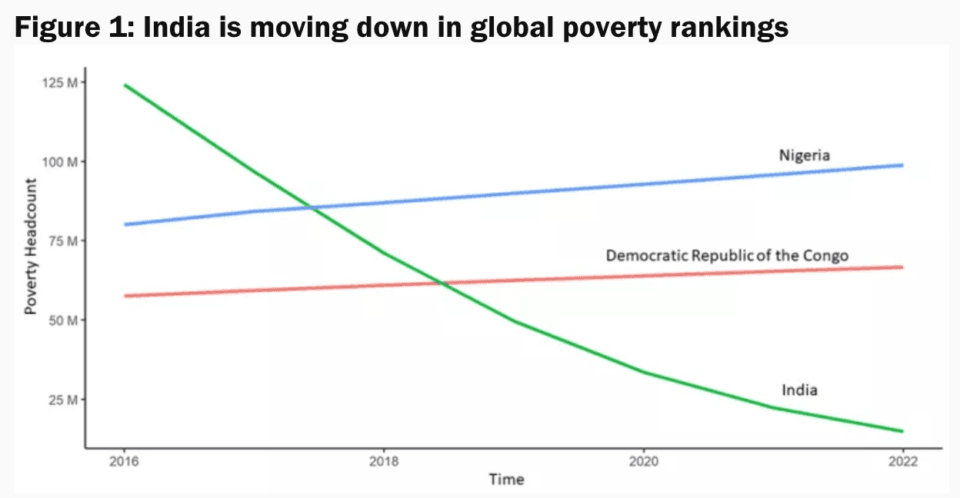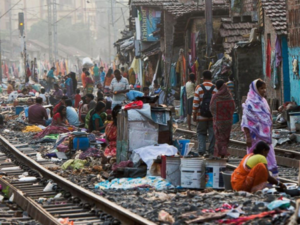A Brookings report has found that India no longer has the world’s most poor people. In fact, poverty in India is on the decline.

n 2018, a Brookings report found that India is no longer the country with the most extreme poverty. Nigeria now has the world’s largest population of people in extreme poverty. Consequently, India is sliding down the global poverty ranking.
The report also says that by 2030, Africa will nine-tenths of the world’s poor living on its continent.
What does the report say?
The Brookings report in question is authored by three people: Interim vice president and director of global economy and development, Homi Kharas; COO of World Data Lab, Kristofer Hamel, and research analyst for World Data Lab, Martin Hofer.
The three have based their findings on data collected by the World Poverty Clock, an online ticker tool that displays global poverty and population statistics.
The World Poverty Clock evaluates information from 188 countries and territories to develop its projections on global poverty.
The Brookings report specifically discusses “extreme poverty”, which means a severe lack of access to education, healthcare, electricity, sanitation, and clean water.
People stuck in extreme poverty also suffer gender inequality and fragile government, says the World Bank.
“According to our projections, Nigeria has already overtaken India as the country with the largest number of extreme poor in early 2018, and the Democratic Republic of the Congo could soon take over the number two spot”, said Kharas, Hamel, and Hofer.

While the Nigerian population continues to fall into poverty, Indian demographics are being lifted up.
“By the end of 2018 in Africa as a whole, there will probably be about 3.2 million more people living in extreme poverty than there are today”, estimated this report.
As of 2018, Africa accounted for two-thirds of the world’s “extreme poor”. If this trend persists, by 2030, 14 of the 18 countries on the continent will be home to nine-tenths of the world’s poor.
The report also said that it is becoming increasingly more difficult to achieve the poverty-linked Sustainable Development Goals (SDG) that were internationally agreed upon in 2016. The SDG framework hoped for global poverty will be eradicated by 2030.
However, to meet this target, 35 million people will need to be immediately uplifted from extreme poverty. This means that from needing to lift 1.5 persons out of poverty every second, the world needs to alleviate poverty for 1.6 people per second.
“At the same time, because so many countries are falling behind, the actual pace of poverty reduction is starting to slow down. Our projections show that by 2020, the pace could fall to 0.9 people per second, and to 0.5 people per second by 2022”, said the report.
Conflicting estimates, but India improves
While the Indian government officially reports that poverty in India is improving, different committees have found conflicting data.
In 2014, the Rangarajan Committee redefined the poverty line from the Tendulkar Committee’s previously recommended Rs. 27 in rural areas and Rs. 33 in urban areas to Rs. 32 and Rs. 47 respectively.
The Rangarajan Committee’s poverty line increases the number of poor people in India to 260.5 million from the Tendulkar committee’s number of 216.5 million.
The Rangarajan Committee found that India has 19% more poor people in rural areas and 41% more in urban areas than previously estimated.
However, the Planning Commission decided to stick with the Tendulkar method while reporting the 2011-12 statistics on poverty.
In 2012, the BBC found that India’s embracing of welfare schemes was helping reduce national poverty, especially in rural areas.
The Planning Commission said that the main reason for India’s decline in poverty was that the government was spending more on rural welfare programmes.
“This is not surprising. Such an outcome is on expected lines as this is the period when the government increased the expenditure on flagship programmes substantially”, said Planning Commission member Mihir Shah.
Rhea Arora is a Staff Writer at Qrius.
Reference:




















